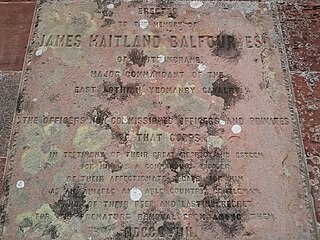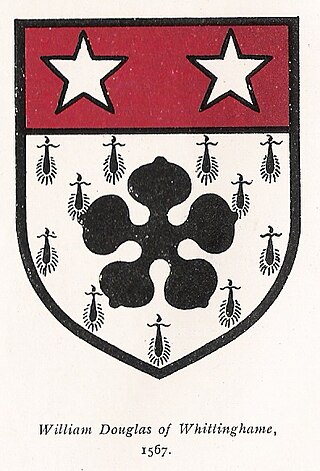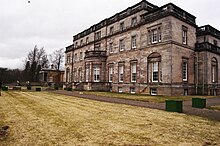
East Lothian is one of the 32 council areas of Scotland, as well as a historic county, registration county and lieutenancy area. The county was called Haddingtonshire until 1921.

The title Earl of Morton was created in the Peerage of Scotland in 1458 for James Douglas of Dalkeith. Along with it, the title Lord Aberdour was granted. This latter title is the courtesy title for the eldest son and heir to the Earl of Morton.

James Maitland Balfour was a Scottish land-owner and businessman. He made a fortune in the 19th-century railway boom, and inherited a significant portion of his father's great wealth.

James Douglas, the 4th Lord of Dalkeith, was created the 1st Earl of Morton in 1458.

Mary Balfour Herbert (1817–1893) was a British artist. She was born Mary Balfour in 1817, the daughter of James Balfour MP and Lady Eleanor Maitland; they were grandparents of Arthur Balfour 1st Earl Balfour. She grew up in Whittingehame House, East Lothian, Scotland, and travelled widely during her childhood. She took drawing lessons but had no other formal art education.

Stenton is a parish and village in East Lothian, Scotland. It is bounded on the north by parts of the parishes of Prestonkirk and Dunbar, on the east by Spott and on the west by Whittingehame. The name is said to be of Saxon derivation. The village has a number of houses, a school, and a church.

Morham, East Lothian, sometimes spelt Moram, Morum, or Morhame in old records, is the smallest (agricultural) parish in Scotland, sandwiched between five other parishes: Haddington, Garvald, Yester, Whittingehame, and Prestonkirk, in the undulating lower reaches of the Lammermuir Hills.

Sir Alexander Seton, 1st Viscount of Kingston, a Cavalier, was the first dignity Charles II conferred as King.

Garvald is a village south-east of Haddington in East Lothian, Scotland. It lies on the Papana Water south of the B6370, east of Gifford. The combined parish of Garvald and Bara, borders Whittingehame to the East, Morham to the North, Yester to the West, and Lauder to the South. It is mainly an agricultural parish. The red freestone once constantly mined in this parish was well known throughout the whole country.
Nunraw is an estate in East Lothian, Scotland. It includes the White Castle, a hillfort, situated on the edge of the Lammermuir Hills, two miles south of the village of Garvald, Nunraw House was formerly used as the Guesthouse for retreatants at Sancta Maria Abbey the Cistercian monastery on the hillside nearby. Sir James Balfour Paul, Lord Lyon King of Arms, writing in 1905 stated that Whitecastle and Nunraw are the same place and that the lairds there were often referred to by one or the other of these territorial designations.

William Douglas of Whittingehame was a Senator of the College of Justice at Edinburgh, and a Royal conspirator.
Robert Lauder of The Bass was an important noble in Haddingtonshire, the Merse, and Fife. Stodart remarks that "to 1600 the barons of the Bass sat in almost every parliament". He was a firm supporter of Mary, Queen of Scots whom he accompanied to Carberry Hill on 14 June 1567, and fought for at the battle of Langside.

Sir Robert de Lawedre (Lauder), Knt., of Quarrelwood, Edrington, and the Bass was Justiciar of Scotia, a Scottish soldier of great prominence and Captain of Urquhart Castle. He is recorded by Fordun, in his Scotichronicon, and in Extracta ex variis Cronicis Scocie as "Robertus de Lavedir 'the good'"
Ada de Warenne was the Anglo-Norman wife of Henry of Scotland, Earl of Northumbria and Earl of Huntingdon. She was the daughter of William de Warenne, 2nd Earl of Surrey by Elizabeth of Vermandois, and a great-granddaughter of Henry I of France. She was the mother of Malcolm IV and William I of Scotland.
James Douglas, 1st Lord Dalkeith was a Scottish nobleman born in Dalkeith, Midlothian, Scotland to Sir James Douglas and Agnes Dunbar. James was the brother of Nicholas Douglas, 1st Lord of Mains.

Whittingehame Tower, or Whittingehame Castle, is a fifteenth-century tower house about 2.5 miles (4.0 km) south of East Linton, on the west bank of Whittinghame Water in East Lothian, Scotland.

James Balfour was a Scottish nabob who became a landowner and politician. The son of a prosperous and influential Scottish gentry family, he became a trader in India. Having made a fortune supplying the Royal Navy, he returned to Scotland to buy several landed estates, including Whittingehame in East Lothian where he built a classical mansion.
William Roy Sanderson was a Scottish minister who served as Moderator of the General Assembly of the Church of Scotland in 1967. In 1961 he had organised the first meeting between a moderator and the pope. He was chaplain in ordinary to Queen Elizabeth II in Scotland.
Richard Douglas was a Scottish landowner, courtier, and letter writer.



















